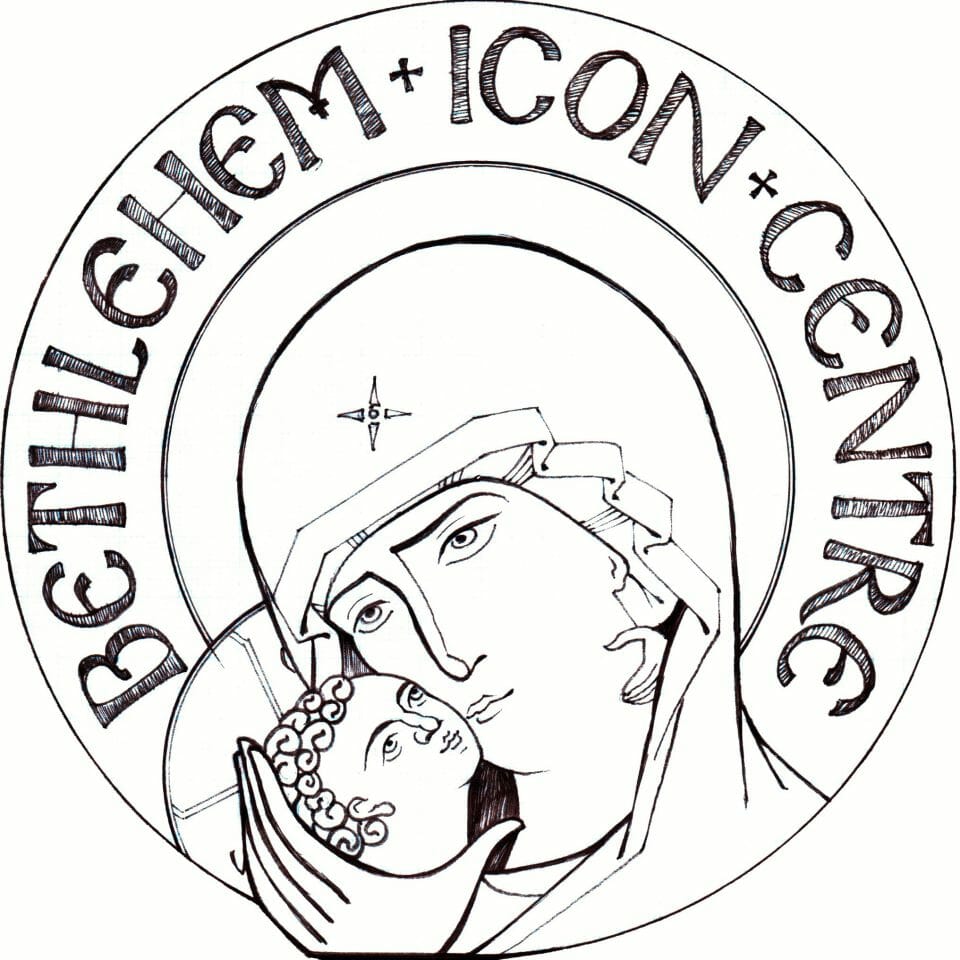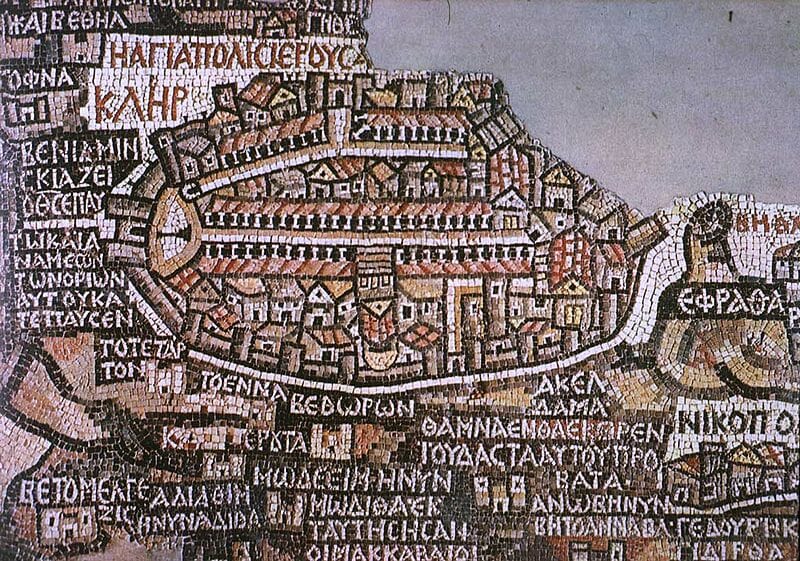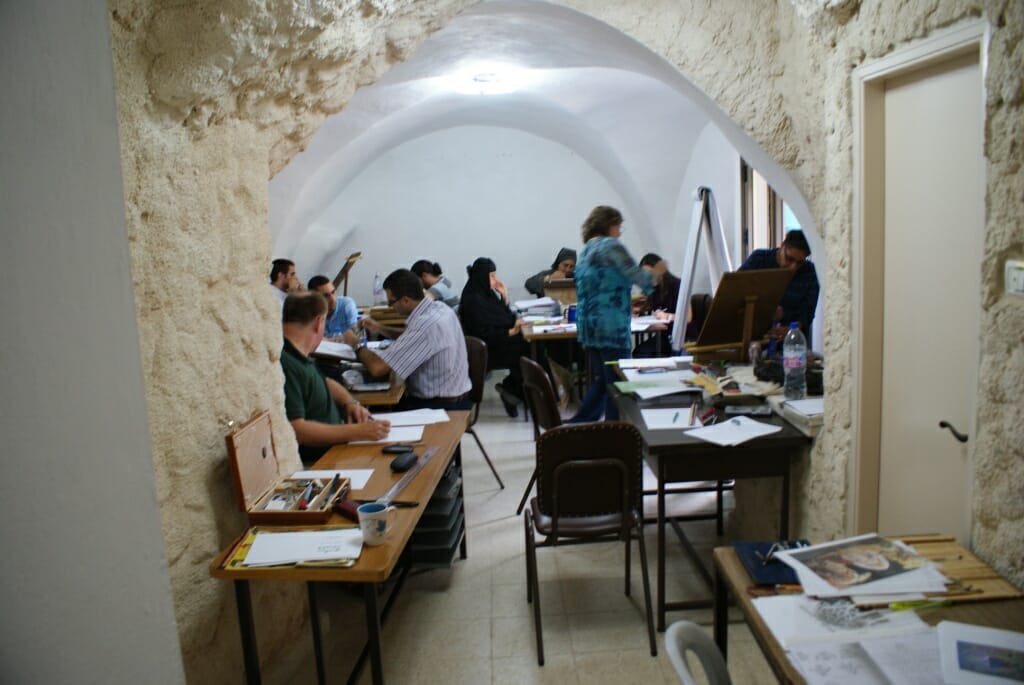Similar Posts
Editorial Note: In the light of recent events in Gaza, I asked Ian Knowles the Director of the Bethlehem Icon Center to introduce us to this wonderful project. In such a desperate political situation, sacred art has been focal point to bring about collaboration between Orthodox, Coptic, Catholic and Syrian Palestinians in the desire to restore traditional iconography to the Holy Land.
The article is by Ian Knowles.
Art expresses culture, that is the shared attitudes, values, goals, practices etc. that characterise a society, group, institution or organisation. It enables these to be passed on to the next generation, or shared among new members, or to re-invigorate those who already belong. Liturgical art expresses the very heart of Christian culture, for it is the fruit of the most profound experience which lies at the heart of the Christian faith: theosis, the transfiguration of humanity through the encounter with God in Jesus Christ. Liturgical art is thus much more than simply how you decorate a church wall.
The Holy Land was, I believe, the place where Christianity first began to shape its own culture. Jerusalem, Bethlehem, the Holy Land… these take us to the heart of the Christian revelation, the places where the Word became flesh and dwelt among us, but which was also, for the 300 yrs between 324AD and 622AD, the spiritual heart of the Roman/Byzantine Empire. My own research suggests that a truly Christian liturgical art came to birth in the Holy Land during the 6th century when Palestine was the jewel in the Byzantine crown. For a brief couple of hundred years Christians shaped and ruled and populated the Holy Land, and literally it blossomed. Monasteries and farms littered the desert and creativity and trade were a marvel to behold, as you can see today by visiting the amazing ruins of Madaba in Jordan.
Literally millions of pilgrims came to visit the holy places, and many of them stayed, some as monks others to work. Some estimate that the population reached a million at its height, the greatest number at any time in history prior to the 20th century. By the 7th century there were 10,000 monks living around Jerusalem alone. The combination of the sacred sites and the developed liturgy that took place there, together with the depth of the spiritual life of the monks and others who settled in Palestine, ensured that this Christian experience shaped the society there more intensely than anywhere else. The great basilicas which we see in Jerusalem and Bethlehem today are just the last, rather battered remnants of a golden era of Christian culture. And once we realise that St Catherine’s monastery in Sinai was very much part of Byzantine, then its amazing collection of icons is a rich seam that takes us back through the centuries, giving us a rare glimpse of the golden age of the holy land that enabled a true Christian liturgical art to emerge and flourish.
The situation Christians live in now couldn’t be any more different. Arab Christians are beleaguered; the more able and talented have left, while the ranks of the senior clergy is almost entirely occupied by foreigners, the monasteries are largely empty and the Christian holy sites are in danger of becoming a sort of Christian theme park. When the State of Israel was created in 1948 the number of Christians, even after 1500 yrs of Muslim rule, stood at about 20%. Since then the region has been racked by war and violence, and while millions of Jews from around the world have taken up residence in the Holy Land, millions of Christians have left, so that now the Christian presence numbers just above 1%. Jerusalem is now claimed as the capital of a Jewish State, while Bethlehem is, for the first time since the Byzantine era, a city where Christians are a minority. Arab Christian society is decimated, mesmerised by the attraction of Europe and the USA, dependant on aid, and pitted by corruption all against a backdrop of incessant war and violence. It is a crisis of massive proportions and one which has robbed the Holy Land of much of its ancient and rich Christian culture.
Our Lady of the Wall is an icon painted by Ian on the shameful wall that boxes Palestinians into their quarters. A glimpse of hope and peace in a hostile environment.
Iconography is one lingering strand of that ancient culture that still holds on, just; the vast majority of Arab Christians are either Greek Orthodox or Greek Catholics, where of course iconography is still an intrinsic part of Christian worship. However, as one young Arab Orthodox woman explained to me, they seem part of a foreign Greek or Russian culture, not something that really belongs to the Arab Christians themselves. Furthermore, there are almost no native Arab iconographers of any merit. I know of one in Bethlehem and one in Jerusalem who are really committed and accomplished at their art, while the rest are generally poorly trained amateurs who flog their impoverished work through a network of less scrupulous tourist shops. There are other iconographers, such as myself and some religious, but we are not native to the land and alien to its culture.
Of course icons are also an important part of Israel’s very lucrative tourist industry. The market in old icons was big business, especially with the arrival of Russians in the late 1980s onwards. They brought out their family icons and promptly sold them. Then the mafia followed up by smuggling icons out of Russia until the authorities cracked down on this devastation of Russia’s religious inheritance. Now that the source of old icons has dried up the tourist shop operators are desperate for new ones, though not desperate enough to pay enough for an iconographer to support a family from his work. Usually the iconographer will receive 10% of the final price, while the tour guide who brings in the groups of pilgrims will take a cut of 15%. Thus most local Christians who seek to work as iconographers are left in dire poverty, able only to paint with the poorest materials and with such speed as the quality of the work is mediocre at best. Nor can they afford proper training. It’s a vicious cycle which has debased iconography and added yet another layer of injustice to lives already desperate after decades of occupation.
All of these observations hit me over the time, from 2008, that I was working as a volunteer in the Holy Land as a professional iconographer, and by 2010 I was feeling a spiritual pressure to respond. At first it was running a few classes for some locals in Bethlehem and Jerusalem, but these weren’t really helping very much. Then together with the Greek Catholic sisters in Bethlehem I began to run small residential courses for them and a few international visitors which we called the Bethlehem Icon School. These were good for bringing people into a deeper contact with the living community of Christians in the holy land, but it wasn’t really renewing the culture of the local Christians, and some of those who had attended the classes were asking for something more substantial. One of my enduring encounters was with the Coptic nuns in Bethlehem who were very dedicated to iconography and desperate for their work to contribute to the life of their small convent but who found no one able to really teach them and no one willing to pay anything even vaguely approximate to the labour and materials involved.
So, in 2011 I began to explore how we might set up a centre to produce professional iconographers of the very highest standard, and in a context that could ensure they received a decent income from their work so that a man could support his family. This would give a new trade for the local Christian community, the chance for a young man or woman to support a family, as well as giving the chance for iconography to become rooted back in the life of the very people who live and pray in the holy land. I began to tease out the idea with Fr Timothy Lowe, a priest of the OCA who is the rector of the Tantur Ecumenical Institute just outside Bethlehem, run from the office of the President of the University of Notre Dame Indiana at the behest of the pope, who loved the idea and is now the Chairman of the non profit company we have established to run it.
Back in the UK I discussed the idea with Aidan Hart. Aidan had set up the iconography department at the PSTA in London. I was keen that anything we might do in Palestine would be to the same rigorous standards as Aidan had set out and he proved a tower of strength and wisdom in shaping a version of the PSTA course suitable for the Palestinian context. The Greek Catholic Patriarchal Vicar for Jerusalem, Archbishop Zerey, then agreed to be our patron, while the UK charity, Friends of the Holy Land, agreed to adopt us as one of their projects and so handle all the monies raised.
So I began to beg and beg again from my friends and family in order to raise the cash needed for the project. For a budget of £14,500 I believed we could offer ten students the opportunity to study free for one year. Even my mum contributed, and by the April of 2012 we had secured the promise of enough money to go ahead. I then sought out suitable students, conducted interviews and enrolled 10 Christians from around Bethlehem and Jerusalem to begin in the August.
In August of 2012 we had our first class. There were Greek Orthodox, Latins, Copts and Syrian Orthodox, five men and five women, religious and lay, covering an age range of 19-63! We found a temporary home under the auspices of Bethlehem University, and are exploring the offer of a building from a Palestinian businessman which would be rent free for 10 years if we can get the funding to renovate it. (Please do pray for this!) This would give us a proper atelier or workshop, with exhibition space, a gallery/chapel, reception centre, messy room, workstations and class room as well as an administration area. By the end of October we were registered with the Palestinian Authority as a non-profit company: the Bethlehem Icon Centre, who gave us a licence to teach, promote, sell and generally deal in any way with iconography. That this has all happened so quickly and soundly is surely a sign that this is indeed of God, and that we are truly blessed in this endeavour for his Glory.
The aim is that after three years the students will have reached the point of being able to be professional iconographers with a solid grasp not just of techniques but of the theology and spirituality of the iconographer working at the very heart of the Church’s life. In this way they should be able to teach others, produce works of outstanding quality, and be able to serve their own churches of the Holy Land with real insight and depth of purpose. Perhaps it might just give heart to some of the local Christians, who live just a few miles from the tomb of St John Damascene at St Sabba’s monastery, so that some of their young people will hang on and dig deep to renew their culture and ensure that this most precious art, which belongs to the Holy more than anywhere, can once again flourish from the sources of the faith ‘once delivered to the apostles’. And then, in turn, the Christian presence of the Holy Land won’t loose its most ancient witnesses, its living stones, but instead find the strength to endure until the end while being a beacon of light and hope to a world which is rapidly loosing its faith in Christ.

Group of Students showing off their first icons. On the left is Catholic Archbishop Zerey, patron of the Icon Center. On the right is Ian Knowles.
You can find more information about the Bethlehem Icon Centre and its Icon School at www.bethlehemiconschool.org and it has a page on Facebook.
To see Ian Knowle’s own iconography, see his website: www.eliasicons.co.uk

Archbishop Atallah Hanna (center) from the Greek Orthodox Patriarchate in Jerusalem who came personally to thank Ian (left) for the work done by the Icon Center. On the right is Mitri, the Archbishop’s secretary who is also one of the students at the Center.





[…] Dec 10th 7:01 amclick to expand…The Bethlehem Icon Centre https://orthodoxartsjournal.org/the-bethlehem-icon-centre/Monday, Dec 10th 7:00 amclick to expand…To Thee, O Master Who lovest mankind, I hasten on rising […]
Beautiful story of hope, and how our efforts can change people and the place in which they live. Glory to God!